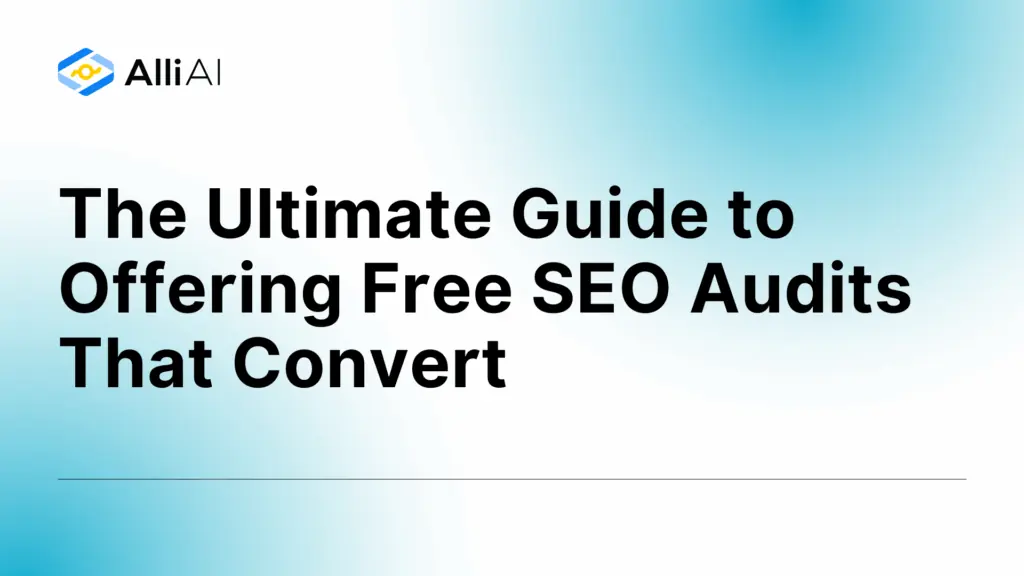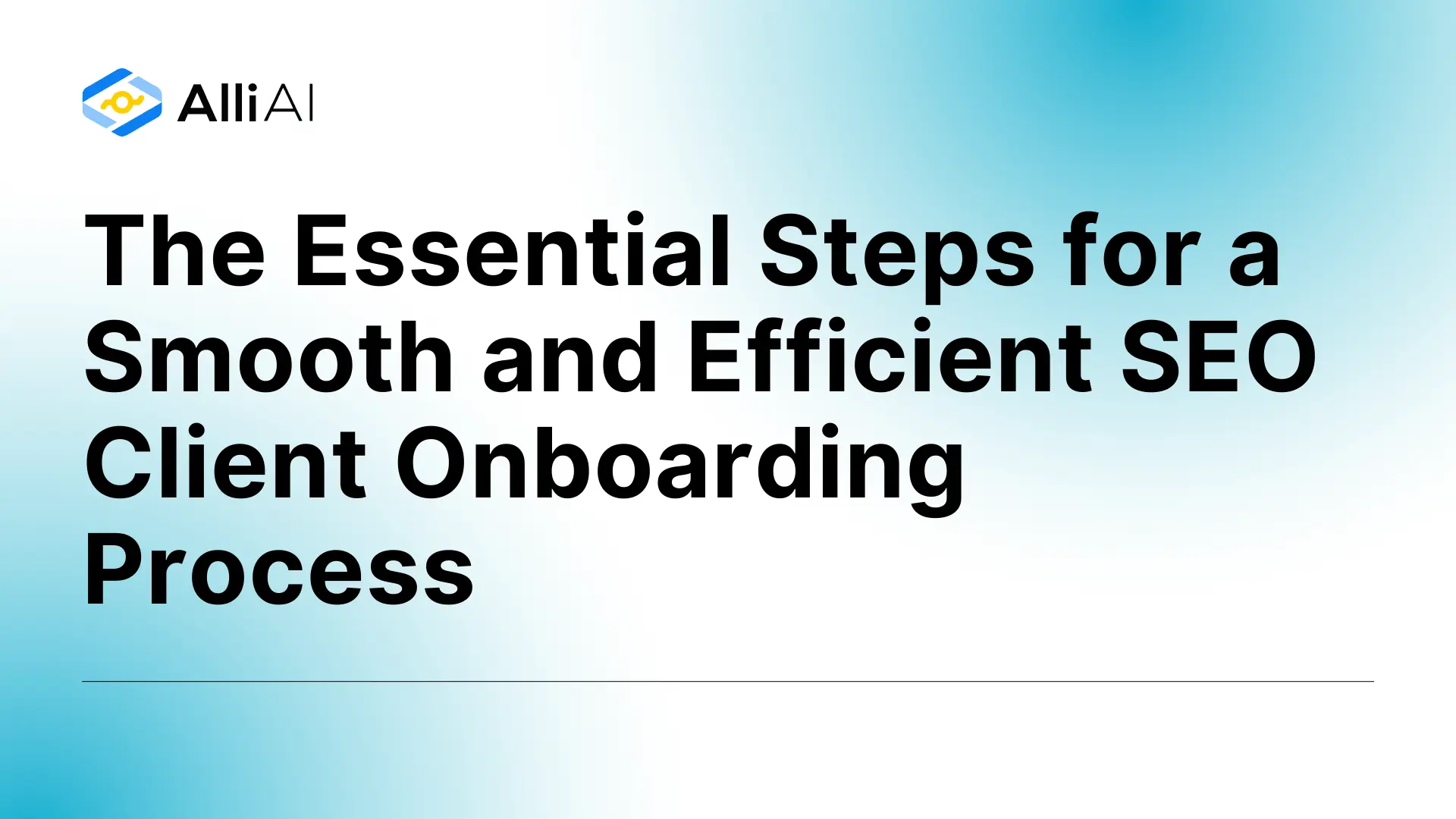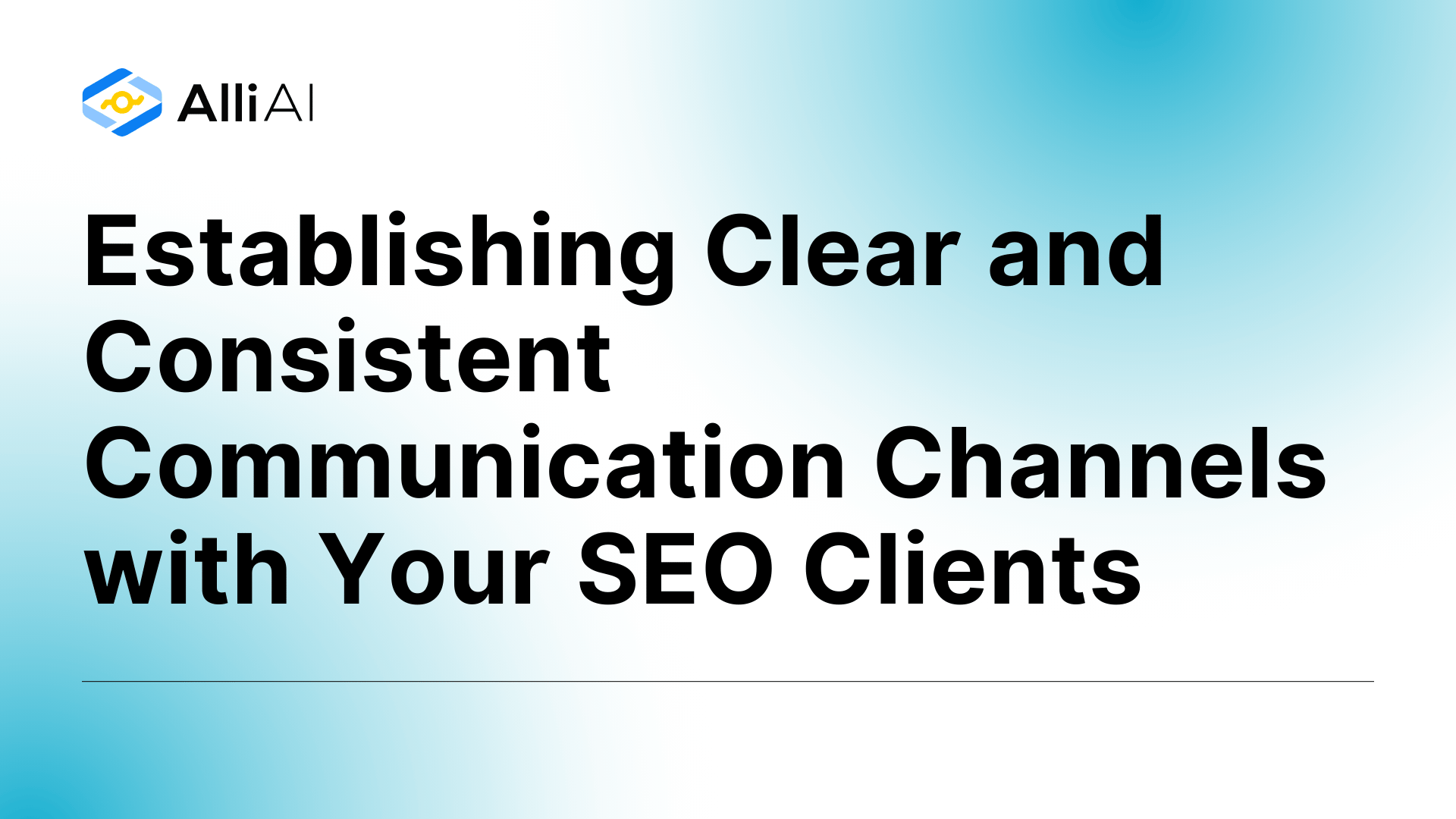Looking to generate more qualified leads for your SEO agency? The “trick” is to offer free SEO audits that showcase your expertise while strategically pointing to your paid services. This is the approach that has helped us convert over 65% of our audit prospects into paying clients, dramatically increasing our agency’s revenue without spending more on advertising.
Many agencies offer free SEO audits, but most make critical mistakes that waste time and resources. They either give away too much valuable information (essentially working for free) or provide generic, automated reports that fail to impress prospects. I’ve found that a well-structured free audit strikes the perfect balance—delivering genuine value while creating a natural bridge to paid services.
In this guide, I’ll walk you through exactly how to create high-impact free SEO audits that actually convert. Let’s get started!
Step #1. Define Your Free Audit’s Scope and Limitations
The first mistake most agencies make is not clearly defining what a “free SEO audit” actually includes. This leads to scope creep, wasted time, and confused expectations.
Your free audit should be a diagnostic tool—a preliminary assessment that identifies potential issues and opportunities without giving away your complete strategic roadmap. Think of it as a “free sample” of your expertise, not the entire meal.
Here’s how to properly scope your free audit:
- Focus on breadth, not depth: Cover the main SEO pillars (technical, on-page, and off-page) but keep the analysis high-level.
- Limit your assessment: Examine only 2-3 key pages rather than the entire site.
- Establish clear boundaries: Be transparent about what you’re NOT including (detailed keyword research, comprehensive backlink analysis, etc.).
A well-defined free audit typically includes:
- Basic technical SEO checks (indexability, mobile-friendliness, site speed)
- Targeted on-page analysis of 1-3 key pages
- A brief off-page/competitive snapshot
We’ve found that setting these clear parameters not only saves us time but also creates a natural distinction between our free offering and our comprehensive paid services. It’s as simple as that.
Step #2. Choose the Right Components for Maximum Impact
Now that you’ve defined your scope, you need to select the specific components that will deliver the most value within those constraints. The goal is to impress prospects with your expertise while clearly illustrating their need for professional SEO services.
Imagine that you’re auditing a local law firm’s website. Rather than listing every minor technical issue, focus on the elements that will have the most immediate business impact and be easily understood by the client.
Here are the most effective components to include:
Technical SEO Checks:
- Indexability status (Are key pages in Google’s index?)
- Mobile-friendliness assessment
- Site speed overview (using Google PageSpeed Insights)
- HTTPS security verification
- Spot check for broken links
- Basic duplicate content scan
On-Page SEO Analysis (for homepage and 1-2 service pages):
- Title tags & meta descriptions review
- Header tag structure evaluation
- Content relevance & structure assessment
- Basic keyword usage check
- Image alt text spot check
- Internal linking structure review
Off-Page & Competitive Snapshot:
- Domain authority/rating overview
- Brief backlink profile glance (referring domains count)
- One competitive comparison point
- Google Business Profile check (for local businesses)
The trick is to select elements that clearly demonstrate problems with tangible business consequences. For example, don’t just report that the site loads slowly—explain how this likely increases bounce rates and reduces conversion opportunities.
Step #3. Select Efficient Tools for Fast, Accurate Audits
Free audits need to be efficient to be profitable lead generation tools. The right combination of tools allows for rapid yet insightful assessments without sacrificing quality.
I’ve tested dozens of tools over the years and found that this specific combination works best for balancing speed and value:
Essential Free Tools:
- Google Search Console (indexation status, crawl errors, mobile usability)
- Google PageSpeed Insights (performance metrics, Core Web Vitals)
- Google Mobile-Friendly Test
- Screaming Frog SEO Spider (free version, 500 URL limit)
- Ahrefs Webmaster Tools or Free Backlink Checker
- SEOptimer (free check)
Paid Tools for Enhanced Efficiency:
If you’re serious about scaling your audit process, consider selective use of:
- Semrush (comprehensive site audit capabilities)
- Ahrefs (stronger for backlink analysis)
- Screaming Frog SEO Spider paid version (removes crawl limits)
- Alli AI (onpage SEO audit)
Your first thought might be to simply forward automated reports from these tools. However, I’ve found that the real value comes from your interpretation of the data, not the raw metrics themselves. Use the tools to gather information quickly, but always apply your expert analysis to contextualize the findings.
For example, when using Screaming Frog to identify missing meta descriptions, don’t just report “15 pages missing meta descriptions.” Instead, explain how this likely impacts click-through rates from search results, potentially costing the business valuable traffic and leads.
Table 1: Recommended Free SEO Audit Components Checklist
| Component Area | Specific Check | Tool(s) Suggestion | Value Provided to Prospect | Area for Paid Upsell |
| Technical | Indexability Status (Key Pages) | Google Search Console, site: search | Identifies if critical pages are visible to Google | Full indexation audit, crawl budget optimization, fixing indexing errors |
| Technical | Robots.txt & XML Sitemap Review | Manual Check, GSC | Flags potential crawl blocking issues | Sitemap optimization, robots.txt configuration, crawl path analysis |
| Technical | Mobile-Friendliness | Google Mobile-Friendly Test, Lighthouse | Assesses usability on mobile devices | Responsive design fixes, mobile UX optimization |
| Technical | Site Speed Overview (Core Web Vitals) | Google PageSpeed Insights | Highlights major speed issues impacting UX & rankings | Detailed performance analysis, Core Web Vitals optimization, code/image optimization |
| Technical | HTTPS Security | Browser Check | Confirms secure connection | Mixed content issue resolution, security hardening |
| Technical | Broken Links (Spot Check) | Screaming Frog (Free) | Shows examples of poor UX & crawl issues | Comprehensive broken link fixing, redirect strategy implementation |
| On-Page | Title Tags & Meta Descriptions (Key Pages) | Manual Check, Screaming Frog (Free) | Assesses presence, length, basic relevance | Full title/meta optimization, keyword mapping, CTR optimization |
| On-Page | Header Tags (H1, H2 Structure on Key Pages) | Manual Check, Screaming Frog (Free) | Checks basic content structure & H1 usage | Sitewide heading structure optimization, semantic content structuring |
| On-Page | Content Relevance & Structure (Qualitative Check) | Manual Review | Gauges if content meets basic user needs & readability | Content gap analysis, content creation/rewriting, E-E-A-T improvement |
| On-Page | Image Alt Text (Spot Check) | Manual Check, Screaming Frog (Free) | Identifies missed accessibility & image SEO opportunities | Comprehensive image optimization (alt text, file size, format) |
| On-Page | Internal Linking (Spot Check on Key Pages) | Manual Check, Screaming Frog (Free) | Looks for basic connectivity & potential orphaned pages | Strategic internal linking plan, site architecture optimization |
| Off-Page/Comp. | Domain Authority/Rating Overview | Moz Link Explorer (Free), Ahrefs Free | Provides a high-level authority benchmark | In-depth backlink analysis, link quality assessment, link building strategy |
| Off-Page/Comp. | Backlink Profile Glance (Referring Domains Count) | Ahrefs Free, Semrush Free | Gives basic sense of link profile size | Competitor backlink gap analysis, targeted link acquisition |
| Off-Page/Comp. | Competitor Comparison Point (e.g., Traffic Est.) | Semrush Free, Ahrefs Free, Similarweb | Provides context relative to one competitor | Full competitive landscape analysis, strategic positioning |
| Off-Page/Comp. | Google Business Profile Check (If Local) | Google Search/Maps | Verifies presence & basic completeness for local visibility | Full GBP optimization, citation building, local review management |
Step #4. Balance Automation with Manual Expertise
The most effective free audits blend the efficiency of automation with the irreplaceable value of human expertise. This is where you’ll truly differentiate your agency from competitors who simply generate automated reports.
Here’s how we structure our process:
- Automate Data Collection: Use your selected tools to rapidly gather technical metrics, crawl data, and performance indicators.
- Apply Manual Review: Dedicate expert time to:
- Verify critical findings (don’t blindly trust tool output)
- Assess qualitative aspects like content relevance and user experience
- Contextualize data within the prospect’s specific business and industry
- Prioritize issues based on potential impact
- Add Value Beyond the Report: Layer your strategic insights on top of the raw data.
The trick is finding the right balance. We typically spend about 60% of our audit time on automated data collection and 40% on manual review and interpretation. This approach allows us to complete most free audits in 1-2 hours while still delivering genuine insights.
For instance, when reviewing a site’s Core Web Vitals, don’t just report the numbers—explain why they matter to this specific business and how improvements might impact user engagement and conversions.
Table 2: Comparison of Popular SEO Audit Tools (Free vs. Paid Aspects for Initial Audits)
| Tool Name | Primary Use Case | Key Free Version Features/Limits | Key Paid Version Advantages (for audits) | Indicative Cost | Analyst Note |
| Google Search Console (GSC) | Technical, Performance | Indexing, crawl errors, manual actions, basic performance data | N/A (Free tool) | Free | Essential baseline data directly from Google. |
| Google PageSpeed Insights | Technical (Speed) | Core Web Vitals, performance scores, basic recommendations | N/A (Free tool) | Free | Quick check for specific page speed issues. |
| Screaming Frog SEO Spider | Technical, On-Page | Crawl up to 500 URLs, find broken links, analyze titles/metas | No crawl limit, JS rendering, GSC/GA integration, scheduling, custom extraction | $ (Annual) | Best for deep technical dives, cost-effective paid version. |
| Ahrefs | All-in-One, Off-Page | Free Webmaster Tools (verified sites), Free Backlink Checker (limited) | Large crawl credits, deep backlink/competitor data, Site Audit tool | $$$ (Monthly) | Industry-leading backlink data, strong overall feature set. |
| Semrush | All-in-One | Very limited Site Audit (100 URLs/mo), basic keyword/domain data | Large crawl limits, comprehensive Site Audit, competitor analysis tools | $$$ (Monthly) | Robust all-around suite, good reporting and issue recommendations. |
| Bing Webmaster Tools | Technical, Performance | Bing-specific data, site scan, keyword tools, Microsoft Clarity | N/A (Free tool) | Free | Important for Bing visibility, Clarity offers unique UX insights. |
| Ubersuggest | All-in-One | Limited daily usage for site audit, keywords, competitor analysis | Higher limits, more features | $$ (Monthly/Life) | Often positioned as a more affordable all-in-one option. |
| Moz Pro | All-in-One, Off-Page | Free tools (Link Explorer, Keyword Explorer – limited), MozBar | Site Crawl, Rank Tracking, Domain Authority tracking, Campaign dashboard | $$$ (Monthly) | Known for Domain Authority metric, good educational resources. |
| Alli AI | On-Page Automation, All-in-One | Free 10-day trial available for paid plans | AI driven audits, automated implementation of on-page fixes (code/content), schema generation, internal linking, bypasses CMS limits for changes | Focuses on automating implementation of on-page SEO recommendations; aims to bypass dev queues. Mixed reviews on effectiveness vs. cost. |
(Cost indicators: Free, $ = Low, =Medium,$ = High relative to other SEO tools)
Step #5. Present Findings in a Format That Drives Conversion
The way you present your audit findings dramatically influences conversion rates. Even the most insightful analysis will fall flat if it’s not communicated effectively.
We’ve tested multiple presentation formats and found these work best:
PDF Reports:
- Pros: Tangible takeaway, easily shared internally by prospect
- Cons: Can feel impersonal, easy to set aside and forget
- Best for: Prospects who need to share findings with internal stakeholders
Video Walkthroughs:
- Pros: Personal touch, visual demonstration of issues
- Cons: Requires more creation time, less scannable
- Best for: Visual learners, complex issues that benefit from demonstration
Consultation Calls:
- Pros: Real-time interaction, immediate Q&A, builds rapport
- Cons: Scheduling challenges, prospect may not retain all details
- Best for: Well-qualified leads, complex situations
The most effective approach we’ve found is a hybrid model: send a concise PDF summary first, followed by a focused consultation call to discuss key findings and next steps. This gives prospects time to review the material but still ensures direct interaction.
Regardless of format, structure your presentation using this Problem → Impact → Solution framework:
- Identify the Problem: Clearly state the specific issue with supporting data.
- Explain the Business Impact: Translate technical problems into business consequences.
- Position Paid Services as the Solution: Naturally transition to how your services address these issues.
For example, instead of simply reporting “Your site has a 75/100 mobile usability score,” say:
“Your website scores only 75/100 on mobile usability (Problem), which likely causes 30% of your mobile visitors to leave without engaging (Impact). Our Mobile Optimization Package would resolve these issues, improving user experience and keeping potential customers on your site longer (Solution).”
Step #6. Implement a Structured Follow-Up System
This is where most agencies drop the ball. Even the best audit is wasted without proper follow-up. We’ve increased our conversion rate by over 20% simply by implementing a consistent follow-up process.
Design your follow-up sequence like this:
- Immediate Follow-Up: Within 24 hours of delivering the audit, send a confirmation email. Include a clear call-to-action for the next step (usually scheduling a call).
- Value-Based Follow-Up: If there’s no response, send 3-5 additional touchpoints over 2-3 weeks. Each should provide additional value rather than just “checking in.” Share relevant case studies, industry insights, or elaborate on a key finding from their audit.
- Multi-Channel Approach: Use a mix of email, phone, and LinkedIn (where appropriate) to maintain visibility without being intrusive.
Every follow-up should include a compelling call-to-action that makes the next step clear and easy. Use phrases like “Book Your Strategy Call” or “Request Your Custom Proposal” with direct links to scheduling tools.
Be prepared to handle common objections during this phase. We’ve found these responses most effective:
- For budget concerns: “I understand budget constraints. Let me show you how our clients typically see a positive ROI within the first 3-4 months.”
- For timing hesitations: “SEO results take time to develop. Starting the process now means you’ll begin seeing improvements by [realistic timeframe].”
The trick is persistent follow-up without being pushy. Your goal is to maintain momentum while continuing to demonstrate value.
Step #7. Avoid Common Pitfalls That Waste Time and Resources
After conducting hundreds of free audits, we’ve identified several pitfalls that can undermine your results. Avoiding these will dramatically improve your ROI on free audits.
Pitfall #1: Auditing Unqualified Leads
The biggest time-waster is conducting audits for prospects who aren’t a good fit for your services.
Solution: Implement pre-qualification measures like:
- A brief discovery call before the audit
- Strategic questions on your audit request form
- Clear definition of your Ideal Client Profile
We’ve reduced wasted audits by 40% simply by asking about marketing budget range and decision-making timeline upfront.
Pitfall #2: Providing Too Much Detail/Solutions
Giving away comprehensive solutions undermines the value of your paid services.
Solution: Focus on identifying problems and explaining their impact, not providing detailed implementation instructions. Position your expertise as essential for effective resolution.
Pitfall #3: Delivering Generic Reports
Automated, template-heavy reports damage credibility and fail to impress prospects.
Solution: Even when using templates, personalize key sections. Add expert commentary and ensure every report directly addresses the prospect’s specific situation.
Pitfall #4: Overwhelming with Technical Data
Dense reports filled with jargon and metrics without clear explanations confuse rather than persuade.
Solution: Use the Problem-Impact-Solution framework to create a clear narrative. Translate technical concepts into business language focused on outcomes.
Pitfall #5: Failing to Connect to Paid Services
Many audits feel like isolated exercises without a clear bridge to your paid offerings.
Solution: Explicitly link identified issues to your specific services. Structure your presentation to naturally lead into your value proposition.
By avoiding these common mistakes, you’ll ensure your free audits remain an effective and profitable lead generation tool rather than a resource drain.
Putting It All Together
Creating free SEO audits that consistently convert requires a strategic approach. By defining clear scope, selecting high-impact components, using efficient tools, balancing automation with expertise, presenting findings effectively, implementing structured follow-up, and avoiding common pitfalls, you’ll transform your free audits from time-consuming freebies into powerful sales tools.
Remember, the goal isn’t to deliver a comprehensive assessment—it’s to demonstrate your expertise while clearly illustrating the value of your paid services. Follow this framework, and you’ll see a significant increase in your conversion rates and agency growth.
Ready to implement this approach? Start by defining your free audit scope today, and you’ll be on your way to more efficient lead generation and higher conversion rates.
Have you tried offering free SEO audits? What challenges have you faced in converting prospects? Share your experiences in the comments below!






